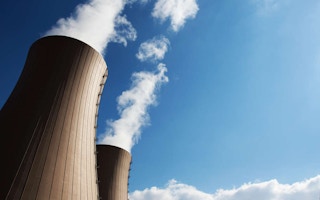The combined contribution of wind, solar and other forms of renewable energy cannot provide enough power for the world to escape the ravages of climate change, according to four prominent scientists.
They say it is essential for society to use nuclear technology as well, though they acknowledge that it needs to be safer than many of today’s plants actually are.
The four scientists are James Hansen, formerly of NASA; Ken Caldeira, of the Carnegie Institution; Kerry Emanuel, of the Massachusetts Institute of Technology; and Tom Wigley, from Australia’s University of Adelaide.
They make their inevitably divisive call in an open letter to environmental groups and politicians worldwide. The US news agency Associated Press (AP) was given an advance copy.
The letter says what is needed is to discuss the role of nuclear power in fighting climate change. It is a realistic suggestion, if you share the authors’ conviction that nuclear energy has a valid contribution to make.
But many environmental analysts and campaigners are vehement that the nuclear route is no option at all, some on safety grounds but others because it is so expensive. They say if the same money were spent on renewables, as happens in Germany, the problem could be solved sooner.
The four scientists say this is unrealistic: they do not believe that new forms of renewable energy will be enough to let the world phase out fossil fuels within a few decades.
They write: “Those energy sources cannot scale up fast enough… with the planet warming and carbon dioxide emissions rising faster than ever, we cannot afford to turn away from any technology”.
Dr Daniel Kammen is co-director of the Berkeley Institute of the Environment at the University of California. He told the Climate News Network: “Nuclear power is certainly low-carbon in the use phase, but the problems with the nuclear fuel cycle, as managed today, are of: cost and extreme accidents.
“Today, nuclear power plants can cost as much as $10 billion for a 1500 MW plant and take a decade to construct. Neither needs to be the case, but at present both are part of the data of plants that are and have been built.
“The call by Hansen et al is for safe and economic nuclear power. If those conditions can be reliably met, it indeed makes a great deal of sense. So far, however, new plants do not meet these thresholds consistently…
“The climate crisis demands significant low-carbon deployment today, and it is not clear if nuclear can meet that immediate challenge.”
Dr Greg Mowry, of the School of Engineering at the University of St Thomas, Minnesota, said: “We may have already messed up the plant beyond recovery, because of greenhouse gases.”
For several reasons, including “public sentiment”, he said: “Nuclear does not seem to be viable at this point. And so we continue the plunge… and seem to be comfortable living with the devil we know – which will ultimately kill us.”
Hansen is credited with having persuaded the US Congress in 1988 of the gravity of climate change, helping to make it a key part of the world’s political and economic agenda. His colleagues all enjoy comparable respect for their work in climate science.
The four do not oppose renewable fuels, Emanuel said, but hope environmentalists will accept that “realistically, they cannot on their own solve the world’s energy problems.”
Hansen told AP environmentalists were “cheating themselves if they keep believing this fiction that all we need” is renewable energy. The joint letter says: “The time has come for those who take the threat of global warming seriously to embrace the development and deployment of safer nuclear power systems.”
The letter’s signatories acknowledge that there are risks, and say: “We understand that today’s nuclear plants are far from perfect.” But they say these risks are far smaller than that posed by extreme climate change.










